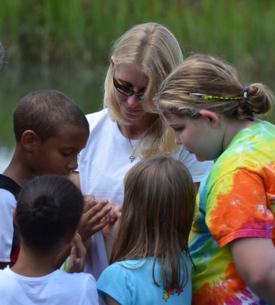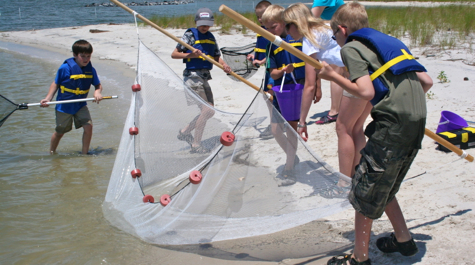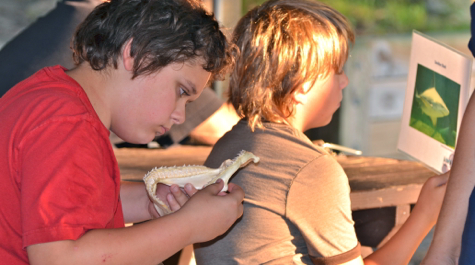VIMS brings outreach outside
New programs expand offerings to beaches, parks, and waterways
Outreach staff at the Virginia Institute of Marine Science charted a new course this summer, expanding the Institute’s educational offerings from labs and campus grounds to local beaches, parks, and waterways.
Susan Maples, Public Outreach Coordinator at VIMS, says “we’ve always supplemented our on-campus events with talks to civic groups, presentations at schools, and participation at local festivals and fairs, but this year we made a conscious decision to bring programs right to the places where people are enjoying Chesapeake Bay and its watershed.”
Maples and outreach specialist Kattie McMillan spent the spring designing and planning a number of new off-campus activities—including “VIMS at the Beach” and “Sharks in the Park,” as well as a hybrid on-campus/off-campus program called “Inside to Seaside.” They also worked with Yorktown Sailing Charters to enhance the “Science Under Sail” partnership first offered in summer 2011.
Despite this summer’s heat and frequent thunderstorms, the programs have proven popular among both local residents and tourists—with 28 off-campus sessions helping hundreds of people better understand Chesapeake Bay, its marine life, and the steps they can take to help protect and restore Bay waters.
In “VIMS at the Beach,” McMillan and volunteers Diane Richman and Loren Reller set up a tent on several occasions at Buckroe Beach in Hampton, Huntington Beach in Newport News, Gloucester Point Beach in Gloucester, and the pocket beach in front of the Watermen’s Museum in Yorktown. They used specimens from the VIMS Fish Collection to provide information about local marine life, answering questions from beach-goers about everything from jellyfish to crabs, summer flounder, sharks, and sea turtles.
During “Sharks in the Park,” McMillan and colleagues traveled to Beaverdam Park in Gloucester to talk with participants about the anatomy and ecology of modern and ancient sharks, as well as the effects of fishing on shark populations. Participants were able to examine shark jaws from the VIMS Fish Collection, and to determine the length of an extinct Megalodon shark based on the size of a fossil tooth.
Gloucester resident Denise Rhea Carter, who attended the event with several members of her extended family, says everyone really enjoyed the program. “We loved it!” says Rhea Carter. “The VIMS crew did a great job.”
Additional “Sharks in the Park” sessions are in the works for other local parks. In the meantime, McMillan and colleagues will return to Beaverdam Park on September 18 between 6:30 and 8:00 pm for a program highlighting the fishing techniques used by Native Americans. The free, hands-on program will showcase traditional techniques used by local tribes as well as the species they typically caught. Details and registration are available on the VIMS Events pages.
 The new “Inside to Seaside” program—offered on selected dates in June, July, and August—was also popular, with several sessions reaching maximum capacity at 30 participants. Sessions began in the Visitors’ Center at VIMS, where program staff used the Center’s aquarium displays and observation pool to help participants recognize local fish, shellfish, and crustaceans. Participants then walked to the nearby beach for an interpreter-led educational seining adventure in the York River, where they caught everything from blue crabs to mummichogs, juvenile red drum, and sheepshead minnows before returning the creatures to the water. McMillan says the participants’ favorite catch was pipefish, needle-shaped creatures just a few inches long.
The new “Inside to Seaside” program—offered on selected dates in June, July, and August—was also popular, with several sessions reaching maximum capacity at 30 participants. Sessions began in the Visitors’ Center at VIMS, where program staff used the Center’s aquarium displays and observation pool to help participants recognize local fish, shellfish, and crustaceans. Participants then walked to the nearby beach for an interpreter-led educational seining adventure in the York River, where they caught everything from blue crabs to mummichogs, juvenile red drum, and sheepshead minnows before returning the creatures to the water. McMillan says the participants’ favorite catch was pipefish, needle-shaped creatures just a few inches long.
Counting those who visited VIMS for recent on-campus events—Marine Science Day, After Hours lectures, hands-on Discovery Labs, summer public tours, summer camps, and workshops—Maples estimates that faculty, staff, and students have interacted with a total of nearly 5,000 people between mid-May and mid-August, through a total of 76 on- and off-campus outreach events.
“We've had a ton of fun this summer,” says Maples, “and made lots of new friends. We designed our new programs to help residents—children and adults—better appreciate the Bay and its marine life, and the feedback we’ve gotten suggests we’ve made a good start toward that goal.”


